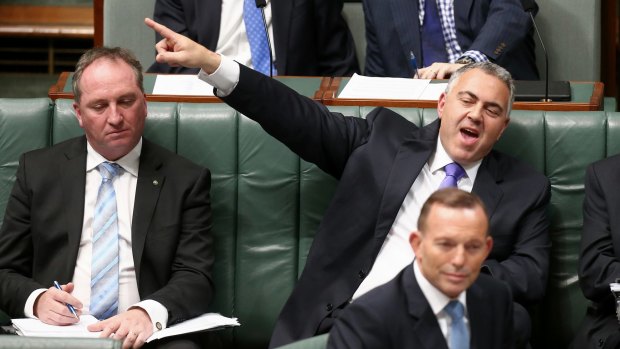By Peter Martin
A maturing of the mining boom and a surge in home building have pushed Australia's economic growth rate to one of the fastest in the developed world, impelling treasurer Joe Hockey to castigate as "clowns" those who had been talking of dark clouds and recession.
Australia's gross domestic product climbed 0.9 per cent in the first quarter of the year to be 2.3 per cent higher than a year ago. All of the growth was accounted for by an expansion of exports, with activities in other parts of the economy cancelling each other out. Investment in houses contributed 0.2 of the 0.9 points, and household spending another 0.3 points. A collapse in business investment cost 0.5 points and a jump in imports another 0.6 points.

The only way (for GDP) is up: Treasurer Joe Hockey and Prime Minister Tony Abbott during Question Time on Wednesday.Credit: Alex Ellinghausen
"These numbers have proven that there are some clowns out there that are talking about recession and dark clouds on the horizon," Mr Hockey said. "They have been proven to be looking foolish, those people, and we should be focusing on what is before us which is raw data that says the Australian economy is in the last quarter, one of the fastest growing economies in the developed world. How good is that?"
Economic growth of 2.3 per cent in the year to March is broadly consistent with the budget's forecast of growth of 2.5 per cent in the year to June followed by a climb to 2.75 in 2015-16 and 3.25 per cent in 2016-17.
The figures show exports surged 5 per cent in the quarter and 8.1 per cent over the year, suggesting that Australia's investment in expanded mining capacity is starting to pay off. But at the same time the price of exports slid 12.5 per cent, meaning that the income brought in from exports fell.
Wages climbed just 0.1 per cent, meaning Australians dipped into their savings to fund a modest 0.5 per cent increase in consumption spending in the quarter and an outsized 4.7 per cent increase in spending on houses - the biggest in half a decade. The construction of new houses climbed 4.8 per cent and spending on alterations and additions surged 4.4 per cent. Over the year housing investment climbed 9.2 per cent.
"This is clear evidence of a construction response to elevated house prices," Mr Hockey said. "Supply is actually increasing to meet demand, but the very low vacancy rates in a number of cities, particularly in Sydney, illustrates there is some way to go."
Away from housing, private construction investment collapsed 12.9 per cent. Government infrastructure investment collapsed 9.1 per cent in the quarter to be almost unchanged over the year.
Victoria was by far the best performing of the states, enjoying an increase in state final demand of 1.3 per cent over the quarter, eclipsing growth of 0.5 per cent in NSW, 0.8 per cent in South Australia, 0.3 per cent in Tasmania and 0.1 per cent in Queensland. Western Australia went backwards shrinking 1.8 per cent.
The treasurer said there was no doubt the transition away from mining construction to mining production was having an impact on Western Australia as it was in Queensland. Victoria and South Australia were benefiting from a lower dollar which has helping manufacturing.
Labor's treasury spokesman Chris Bowen said the government was unable to take credit to the expansion in exports. Despite the boost, economic growth remained lower than it was before Mr Hockey's first budget.
The Australian dollar jumped half a cent on the news. Futures traders wound back their estimate of the likelihood of another interest rate cut in the next nine months from 100 per cent to 50 per cent.